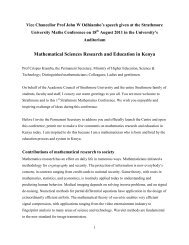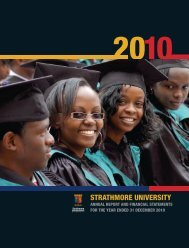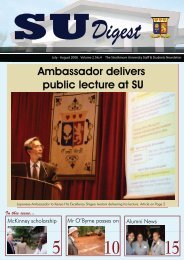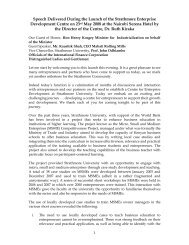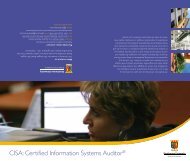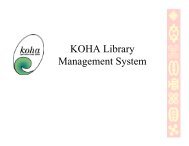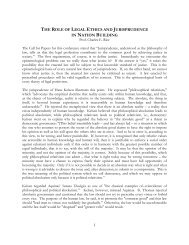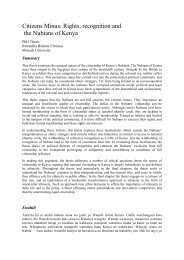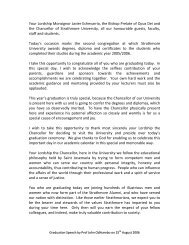Strathmore University Seminar: Kenya as an Emerging Market
Strathmore University Seminar: Kenya as an Emerging Market
Strathmore University Seminar: Kenya as an Emerging Market
- No tags were found...
You also want an ePaper? Increase the reach of your titles
YUMPU automatically turns print PDFs into web optimized ePapers that Google loves.
<strong>Strathmore</strong> <strong>University</strong> <strong>Seminar</strong>: <strong>Kenya</strong> <strong>as</strong> <strong>an</strong> <strong>Emerging</strong> <strong>Market</strong><br />
“Using the Capital <strong>Market</strong>s to Fin<strong>an</strong>ce <strong>Kenya</strong>’s Infr<strong>as</strong>truture”<br />
Presentation by: Ev<strong>an</strong>s Os<strong>an</strong>o – International Fin<strong>an</strong>ce Corporation<br />
Date: 7 th September 2007<br />
Hotel<br />
Venue: Nairobi Hilton
Agenda<br />
Introduction:<br />
What a Bond <strong>Market</strong> c<strong>an</strong> do for <strong>Kenya</strong><br />
Current Status of <strong>Kenya</strong>’s Bond <strong>Market</strong><br />
Challenges to Bond <strong>Market</strong> Development<br />
IFC’s Role in Bond <strong>Market</strong> Development<br />
2
An Introduction to IFC<br />
• Private sector arm of the World B<strong>an</strong>k Group<br />
• IFC fosters sustainable economic growth in developing countries by:<br />
• Fin<strong>an</strong>cing private sector investment<br />
• Mobilizing capital in international fin<strong>an</strong>cial markets<br />
• Providing advisory services to businesses <strong>an</strong>d governments<br />
• Largest Multilateral source of debt <strong>an</strong>d equity fin<strong>an</strong>cing in the developing world<br />
3
IFC <strong>an</strong>d Infr<strong>as</strong>tructure<br />
IFC works with governments <strong>an</strong>d the private sector to:<br />
• Improve b<strong>an</strong>kability of infr<strong>as</strong>tructure projects<br />
• Incre<strong>as</strong>e private sector participation in infr<strong>as</strong>tructure projects<br />
IFC services<br />
• Sector reform & regulatory policy advice (in conjunction with World B<strong>an</strong>k)<br />
• Advice to governments on packaging <strong>an</strong>d presenting deals<br />
• Early stage risk capital <strong>an</strong>d advice to project sponsors<br />
• Project fin<strong>an</strong>ce for PPPs <strong>an</strong>d private infr<strong>as</strong>tructure<br />
IFC operational goals<br />
• Incre<strong>as</strong>e number of fully fin<strong>an</strong>ced & robust private infr<strong>as</strong>tructure projects<br />
• Improve access to b<strong>as</strong>ic infr<strong>as</strong>tructure services for Afric<strong>an</strong>s<br />
4
Introduction<br />
Africa’s infr<strong>as</strong>tructure fin<strong>an</strong>cing needs estimated at US$250 billion in the next 10 years.<br />
Unmet infr<strong>as</strong>tructure <strong>an</strong>d housing needs hamper economic growth <strong>an</strong>d poverty reduction.<br />
Bulk of infr<strong>as</strong>tructure undertaken by the public sector using foreign currency lo<strong>an</strong>s.<br />
Private Sector c<strong>an</strong> contribute in bridging the fin<strong>an</strong>cing gap.<br />
Local fin<strong>an</strong>cial institutions have limited capacity to fin<strong>an</strong>ce infr<strong>as</strong>tructure.<br />
Capital <strong>Market</strong>s c<strong>an</strong> be used to raise long-term local currency fin<strong>an</strong>cing for infr<strong>as</strong>tructure.<br />
5
Introduction - Fin<strong>an</strong>cing Instruments<br />
Equity Fin<strong>an</strong>ce – Long-term capital provided in the form of shares, signifying part<br />
ownerhip in the comp<strong>an</strong>y.<br />
Private Equity – Common with greenfield projects.Institutional Investors make private<br />
equity placements with individual project comp<strong>an</strong>ies.<br />
Project Fin<strong>an</strong>ce - Subordinated Debt (Qu<strong>as</strong>i Equity/Mezz<strong>an</strong>ine Fin<strong>an</strong>ce) – Unsecured<br />
fin<strong>an</strong>ce that is senior to equity but junior to senior debt: May allow participation in the<br />
upside potential of <strong>an</strong> equity position.<br />
Bond <strong>Market</strong>s - Local Currency Project Bonds.<br />
6
Bond <strong>Market</strong>s – Benefits of a Bond <strong>Market</strong> to the Real<br />
Sector<br />
Exp<strong>an</strong>ded housing fin<strong>an</strong>ce<br />
Improved infr<strong>as</strong>tructure fin<strong>an</strong>ce<br />
Improved risk m<strong>an</strong>agement for borrowers i.e.<br />
• Lower interest rates<br />
Builds infra-structure<br />
• Reduced foreign currency risks<br />
Roads; hospitals; schools etc<br />
• Reduced refin<strong>an</strong>cing risks<br />
Improved productivity leading to lower<br />
Improved yields for institutional investors inflation<br />
Incre<strong>as</strong>ed fin<strong>an</strong>cial sector diversification Provides future growth for pension<br />
investments, mortgages <strong>an</strong>d other<br />
Accelerated private sector development<br />
investment opportunities<br />
This creates employment<br />
7
NSE Listed Instruments – As at 30 June 2007<br />
Number<br />
Mkt Cap<br />
Mkt Cap<br />
Turnover<br />
Turnover<br />
Listed<br />
(US$M)<br />
(% of GDP)<br />
(US$M)<br />
Ratio<br />
Equities 54 11,800 43% 628 43%*<br />
Tre<strong>as</strong>ury Bonds 68 4,100 16% 606 30%<br />
Corporate Bonds 6 61 0.2% 0 0<br />
*B<strong>as</strong>ed on estimated 25% free float market cap, Turnover for 6 months of 2007, Ratio <strong>an</strong>nualized<br />
There are only 6 listed corporate bonds in <strong>Kenya</strong> – one is fixed rate<br />
Only Telcoms have made signific<strong>an</strong>t use of the markets in the p<strong>as</strong>t (Safaricom & Celtel)<br />
In 4 years corporate bonds have recorded turnover of only US$82,000 – buy <strong>an</strong>d hold<br />
strategy of institutional investors, small size of issues, structure of issues (floating rate)<br />
8
Status of Bond <strong>Market</strong>s – Yield Curve<br />
YC, QKEBMK= Realtime<br />
15Y, 12.7<br />
YC, QKEBMK= Historical(2007/01/26)<br />
11Y, 14.63<br />
Yield<br />
14.5<br />
14<br />
13.5<br />
13<br />
12.5<br />
12<br />
11.5<br />
11<br />
10.5<br />
10<br />
9.5<br />
9<br />
8.5<br />
8<br />
7.5<br />
7<br />
6.5<br />
6<br />
5.5<br />
5<br />
4.5<br />
4<br />
3.5<br />
3<br />
2.5<br />
2<br />
1.5<br />
1<br />
0.5<br />
0<br />
-0.5<br />
C<strong>as</strong>h 3M 6M 1Y 2Y 3Y 4Y 5Y 6Y 7Y 8Y 9Y 10Y 11Y 12Y 15Y<br />
Source: Reuters Limited<br />
Yield Curve extended to 15 years – but relatively steep.<br />
Study needed to estimate the long-term inflation expectations in <strong>Kenya</strong>.<br />
CBK could consider issuing inflation-linked bonds.<br />
9
Bond <strong>Market</strong>s – Ingredients for a vibr<strong>an</strong>t bond market<br />
• Macro environment<br />
• Legal environment<br />
• Tax environment<br />
• Borrowers with b<strong>an</strong>kable projects<br />
• Informed investors<br />
• <strong>Market</strong> structure in terms regulation <strong>an</strong>d particip<strong>an</strong>ts<br />
• Borrowers, lenders <strong>an</strong>d intermediaries<br />
10
Bond <strong>Market</strong>s – Challenges to a vibr<strong>an</strong>t bond market in<br />
<strong>Kenya</strong><br />
Legal <strong>an</strong>d regulatory environment<br />
• Asset Backed Securities regulations – to facilitate securitization<br />
• Approval process – It takes long to approve issues (up to 9 months)<br />
• Merit versus disclosure b<strong>as</strong>ed approval regime debate<br />
• Issue costs – need to rationalize<br />
Secondary <strong>Market</strong><br />
• <strong>Market</strong> Strucure<br />
• OTC markets – 95% of bonds traded in OTC markets globally<br />
• Settlement risk in a non-DVP environment<br />
•Electronic trading platform for bonds<br />
•Information Assymetry – Price reporting, yield curves <strong>an</strong>d bond indexes<br />
11
Bond <strong>Market</strong>s – Challenges<br />
Lack of instruments<br />
• Currency mismatch – most infr<strong>as</strong>tructure projects fin<strong>an</strong>ced by foreign currency lo<strong>an</strong>s<br />
which carry signific<strong>an</strong>t currency risk (e.g E<strong>as</strong>t Afric<strong>an</strong> Portl<strong>an</strong>d Cement)<br />
• Utilities – Foreign Currency risk p<strong>as</strong>sed on to consumers (KPLC <strong>an</strong>d KenGen)<br />
• Asset/Liability mismatch – When local b<strong>an</strong>ks lend long using short-term deposits<br />
Project Preparation Gap<br />
• Lack of packaged <strong>an</strong>d b<strong>an</strong>kable projects (fin<strong>an</strong>cial viability from st<strong>an</strong>dpoint of fin<strong>an</strong>ciers)<br />
• Weak subnationals (State Owned Entreprises <strong>an</strong>d Municipals) – limited ability to issue<br />
bonds without government guar<strong>an</strong>tees.<br />
• Limited private sector participation in infr<strong>as</strong>tructure development<br />
• Capacity of local intermediaries, investors <strong>as</strong> well <strong>as</strong> issuers<br />
12
Role of Pension Funds in <strong>Kenya</strong><br />
Size of Industry estimated at<br />
US$3.5 billion <strong>an</strong>d growing at<br />
US$200 million p.a<br />
Pension Funds are natural<br />
investors in long-term <strong>as</strong>sets<br />
(Account for 21% of T-bonds)<br />
60%<br />
50%<br />
40%<br />
30%<br />
20%<br />
Pension Funds Investments (%) in Asset Cl<strong>as</strong>ses 2001-2006<br />
Government<br />
Securities<br />
Other Fixed<br />
Income<br />
Quoted<br />
Equity<br />
Property<br />
Private<br />
Equity<br />
Other<br />
…..However are risk averse,<br />
but incre<strong>as</strong>ing investments in<br />
equities questions this.<br />
10%<br />
0%<br />
2001 2002 2003 2004 2005 2006<br />
Data Source, RBA<br />
13
IFC’s Role in Bond <strong>Market</strong> Development<br />
14
ESMID Africa – Program for fostering securities<br />
markets development in Africa<br />
ESMID:<br />
• Efficient<br />
• Securities<br />
• <strong>Market</strong>s<br />
• Institutional<br />
• Development<br />
A partnership between:<br />
• Swedish International<br />
Development Cooporation<br />
Agency (Sida(<br />
Sida)<br />
• International Fin<strong>an</strong>ce<br />
Corporation (IFC)<br />
• World B<strong>an</strong>k<br />
Foster the development of well functioning securities markets in Africa<br />
Improve ability to fin<strong>an</strong>ce infr<strong>as</strong>tructure <strong>an</strong>d housing development through bond markets<br />
15
Countries<br />
• <strong>Kenya</strong><br />
• Ug<strong>an</strong>da<br />
• T<strong>an</strong>z<strong>an</strong>ia<br />
•Rw<strong>an</strong>da<br />
E<strong>as</strong>t Africa<br />
(Regional Approach)<br />
•Nigeria<br />
Country Approach<br />
ESMID will largely work with clusters of countries where ch<strong>an</strong>ges have the potential to<br />
reverberate across several nations, i.e. E<strong>as</strong>t Africa.<br />
16
ESMID Africa – Program for fostering securities<br />
markets<br />
By applying<br />
• World cl<strong>as</strong>s expertise <strong>an</strong>d alli<strong>an</strong>ces<br />
• Local knowledge <strong>an</strong>d alli<strong>an</strong>ces<br />
• Integrated, comprehensive programs<br />
• Long-term commitment<br />
• Practical<br />
• Tr<strong>an</strong>saction geared<br />
Improved ability to<br />
fin<strong>an</strong>ce Infr<strong>as</strong>tructure <strong>an</strong>d<br />
housing + through<br />
securities markets <strong>an</strong>d<br />
products<br />
17
Building <strong>Market</strong>s, Facilitating Tr<strong>an</strong>sactions<br />
Government/Regulators<br />
<strong>Market</strong> Infr<strong>as</strong>tructure/Securities<br />
Exch<strong>an</strong>ges<br />
<strong>Market</strong> Particip<strong>an</strong>ts<br />
Indirect:<br />
Build Securities <strong>Market</strong>s<br />
Provide TA to:<br />
• Create enabling environments<br />
• Build market Infr<strong>as</strong>tructure<br />
• Strengthen market particip<strong>an</strong>ts<br />
Regulators<br />
<strong>Market</strong>place<br />
(trading, clearing, depository)<br />
Issuers<br />
Securities Firms<br />
Direct:<br />
Facilitate Tr<strong>an</strong>sactions<br />
Investors<br />
Funds to support replicable tr<strong>an</strong>sactions:<br />
• Structuring<br />
• Documentation<br />
•Legal fees<br />
The The goal: goal: have have a small small number number of of high high impact impact projects projects that that<br />
demonstrate possibilities <strong>an</strong>d <strong>an</strong>d are are replicable<br />
18
IFC’s Role in Bond <strong>Market</strong> Development in E<strong>as</strong>t Africa<br />
ESMID Africa<br />
Technical Partners<br />
(Securities <strong>Market</strong>s Practitioners/Consult<strong>an</strong>ts)<br />
Local Partners<br />
(CMA, NSE, Intermediaries, etc.)<br />
Assist<strong>an</strong>ce to<br />
Regulators<br />
Processing<br />
Tr<strong>an</strong>sactions<br />
Strengthening the<br />
<strong>Market</strong>place<br />
Capacity Building :<br />
Training<br />
Regionalization<br />
19
ESMID Africa – Legal & Regulatory Assist<strong>an</strong>ce<br />
Identify main obstacles to bond issu<strong>an</strong>ce in laws <strong>an</strong>d regulations<br />
Harmonise issu<strong>an</strong>ce <strong>an</strong>d trading requirements in E<strong>as</strong>t Africa<br />
Clarify documentation requirements <strong>an</strong>d improve processing schedule<br />
Rationalize issu<strong>an</strong>ce costs - High costs discourage bond issu<strong>an</strong>ce<br />
<strong>Market</strong> Structure <strong>an</strong>d bond trading environment: e.g. OTC <strong>Market</strong> Vs listing<br />
20
ESMID Africa – Processing a Tr<strong>an</strong>saction<br />
Bond Issues: Identify bond issues with potential demonstration effect<br />
Cover selected “first-costs” <strong>as</strong>sociated with<br />
Structuring fees,<br />
Documentation fees,<br />
Legal fees<br />
Target: Issuers in housing <strong>an</strong>d infr<strong>as</strong>tructure sectors<br />
21<br />
The The ability ability to to do do a tr<strong>an</strong>saction is is the the beacon beacon<br />
guiding guiding ESMID’s operations
ESMID Africa – Capacity Building & Certification<br />
Regional Certification program<br />
Formal certification procedure for market players<br />
Adoption of enforceable market code of conduct for market particip<strong>an</strong>ts<br />
Training on bonds<br />
Targetted at issuers, investors <strong>an</strong>d intermediaries<br />
Training the Trainers<br />
Develop a local/regional institutional provider<br />
Enh<strong>an</strong>cing capacity <strong>an</strong>d market integrity<br />
Enh<strong>an</strong>cing capacity <strong>an</strong>d market integrity<br />
22
ESMID Africa – Regionalization<br />
Key lessons from relev<strong>an</strong>t international experience on regionalization<br />
• Identify suitable models for regionalization<br />
• Identify gaps <strong>an</strong>d obstacles to regionalization <strong>an</strong>d make suitable<br />
recommendations.<br />
• Develop a road-map for regionalization of E<strong>as</strong>t Afric<strong>an</strong> Capital <strong>Market</strong>s<br />
Regionalization is is a key key operating theme theme for for<br />
ESMID ESMID Africa Africa<br />
23
Conclusions<br />
• Fin<strong>an</strong>cing needs for infr<strong>as</strong>tructure <strong>an</strong>d housing are enormous. The private sector<br />
c<strong>an</strong> play <strong>an</strong> import<strong>an</strong>t role in this exercise.<br />
• The securities markets c<strong>an</strong> be utilized to raise local currency funding for<br />
infr<strong>as</strong>tructure <strong>an</strong>d housing.<br />
• Developing a corporate bond market is a challening <strong>as</strong>signment <strong>an</strong>d requires a lot<br />
of commitment <strong>an</strong>d cordination from stake-holders.<br />
• IFC h<strong>as</strong> a program to develop the bond markets in Africa.<br />
24
Q & A<br />
Q & A<br />
25
26<br />
THANK YOU





